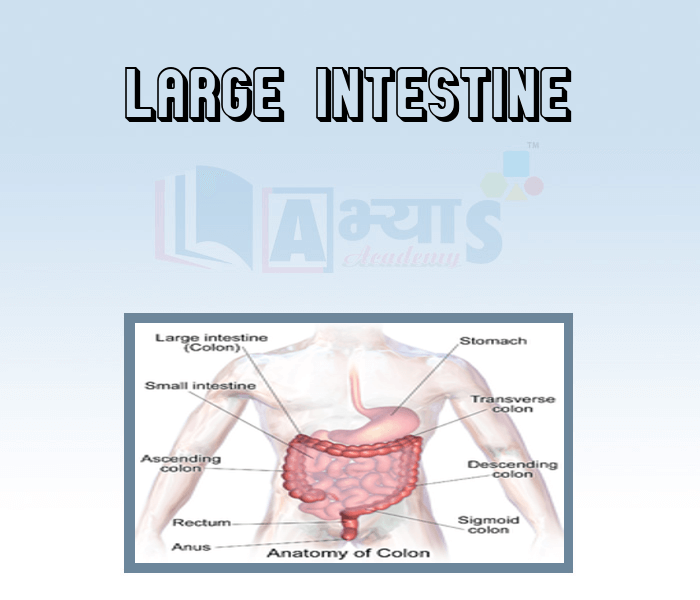Large Intestine


Large Intestine
Intestinal Glands: The complete digestion of the remaining food material takes place in the ‘ileum’ (the last part of the small intestine). There are numerous small glands in the walls of the small intestine. These glands secrete intestinal juices. The digestive enzymes in the intestinal juice break small pepides into amino acids, disaccharides into monosaccharides, lipids into fatty acids and glycerol and nucleic acids into nucleotides.
Large intestine: The ileum passes into the large intestine. It can be divided into two parts: anterior (colon) and posterior (rectum). The colon has an ascending part, a traverse part and a descending part. The last part or the descending part open into the rectum. The terminal part of the rectum is called ‘anal canal’. It opens through the anus, guarded by the ‘sphincter muscles’.
The large intestine allows the passage of residual food mass (faecal matter) which is egested through the anus. As the residue of the food mass passes along the large intestine, a considerable amount of water contained in the residue is absorbed into the blood through the intestinal walls. The specialized longitudinal muscle present in the colon wall regulates the passage of the fecal matter along the colon.
.jpg)
What is the primary function of the large intestine in the digestive system? | |||
| Right Option : D | |||
| View Explanation | |||
Where do the waste products and food that are not absorbed in the small intestine pass? | |||
| Right Option : B | |||
| View Explanation | |||
Which of the following are correct about large intestines? (a) The complete digestion of the remaining food material takes place in the ‘ileum’ (the last part of the small intestine). (b) The ileum passes into the large intestine. It is divided into two parts: anterior (colon) and posterior (rectum). (c) The large intestine allows the passage of residual food mass (faecal matter) which is egested through the anus. | |||
| Right Option : D | |||
| View Explanation | |||
Students / Parents Reviews [10]
Being a parent, I saw my daughter improvement in her studies by seeing a good result in all day to day compititive exam TMO, NSO, IEO etc and as well as studies. I have got a fruitful result from my daughter.

Prisha Gupta
8thAbhyas is a complete education Institute. Here extreme care is taken by teacher with the help of regular exam. Extra classes also conducted by the institute, if the student is weak.

Om Umang
10thAbout Abhyas metholodology the teachers are very nice and hardworking toward students.The Centre Head Mrs Anu Sethi is also a brilliant teacher.Abhyas has taught me how to overcome problems and has always taken my doubts and suppoeted me.

Shreya Shrivastava
8thMy experience with Abhyas is very good. I have learnt many things here like vedic maths and reasoning also. Teachers here first take our doubts and then there are assignments to verify our weak points.

Shivam Rana
7thOne of the best institutes to develope a child interest in studies.Provides SST and English knowledge also unlike other institutes. Teachers are co operative and friendly online tests andPPT develope practical knowledge also.

Aman Kumar Shrivastava
10thIt has a great methodology. Students here can get analysis to their test quickly.We can learn easily through PPTs and the testing methods are good. We know that where we have to practice

Barkha Arora
10thI have spent a wonderful time in Abhyas academy. It has made my reasoning more apt, English more stronger and Maths an interesting subject for me. It has given me a habbit of self studying

Yatharthi Sharma
10thIt was good as the experience because as we had come here we had been improved in a such envirnment created here.Extra is taught which is beneficial for future.

Eshan Arora
8thIt was a good experience with Abhyas Academy. I even faced problems in starting but slowly and steadily overcomed. Especially reasoning classes helped me a lot.

Cheshta
10thMy experience was very good with Abhyas academy. I am studying here from 6th class and I am satisfied by its results in my life. I improved a lot here ahead of school syllabus.
